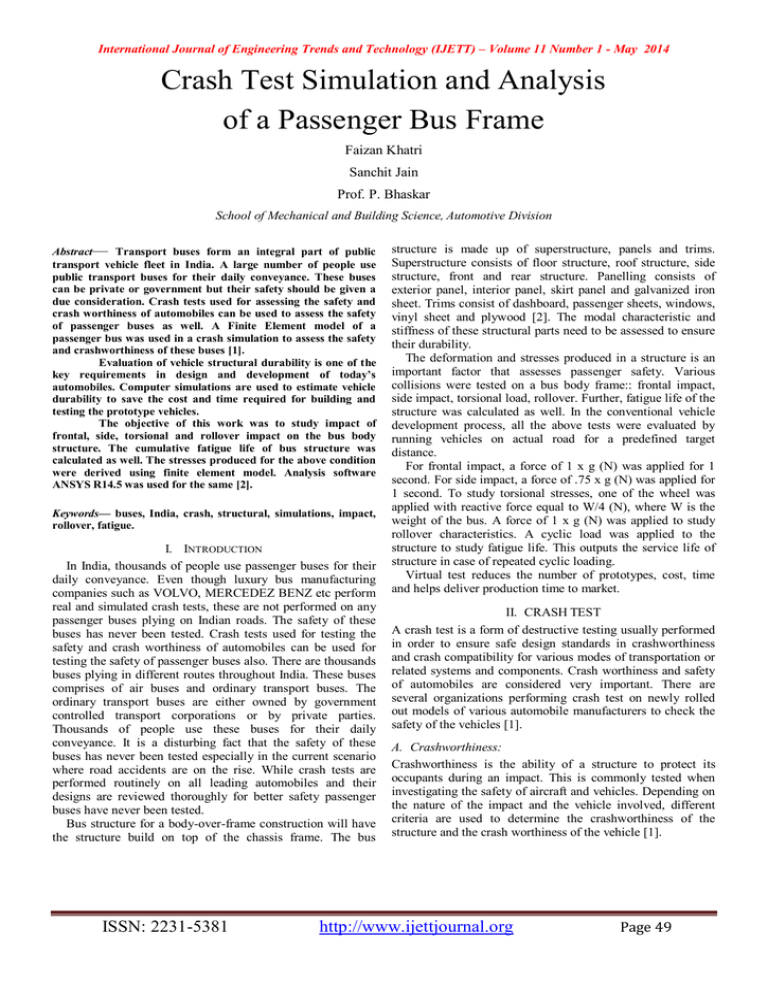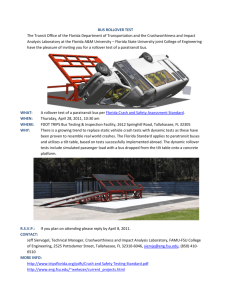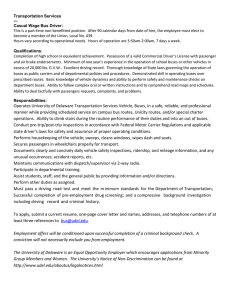Crash Test Simulation and Analysis of a Passenger Bus Frame —
advertisement

International Journal of Engineering Trends and Technology (IJETT) – Volume 11 Number 1 - May 2014 Crash Test Simulation and Analysis of a Passenger Bus Frame Faizan Khatri Sanchit Jain Prof. P. Bhaskar School of Mechanical and Building Science, Automotive Division Abstract— Transport buses form an integral part of public transport vehicle fleet in India. A large number of people use public transport buses for their daily conveyance. These buses can be private or government but their safety should be given a due consideration. Crash tests used for assessing the safety and crash worthiness of automobiles can be used to assess the safety of passenger buses as well. A Finite Element model of a passenger bus was used in a crash simulation to assess the safety and crashworthiness of these buses [1]. Evaluation of vehicle structural durability is one of the key requirements in design and development of today’s automobiles. Computer simulations are used to estimate vehicle durability to save the cost and time required for building and testing the prototype vehicles. The objective of this work was to study impact of frontal, side, torsional and rollover impact on the bus body structure. The cumulative fatigue life of bus structure was calculated as well. The stresses produced for the above condition were derived using finite element model. Analysis software ANSYS R14.5 was used for the same [2]. Keywords— buses, India, crash, structural, simulations, impact, rollover, fatigue. I. INTRODUCTION In India, thousands of people use passenger buses for their daily conveyance. Even though luxury bus manufacturing companies such as VOLVO, MERCEDEZ BENZ etc perform real and simulated crash tests, these are not performed on any passenger buses plying on Indian roads. The safety of these buses has never been tested. Crash tests used for testing the safety and crash worthiness of automobiles can be used for testing the safety of passenger buses also. There are thousands buses plying in different routes throughout India. These buses comprises of air buses and ordinary transport buses. The ordinary transport buses are either owned by government controlled transport corporations or by private parties. Thousands of people use these buses for their daily conveyance. It is a disturbing fact that the safety of these buses has never been tested especially in the current scenario where road accidents are on the rise. While crash tests are performed routinely on all leading automobiles and their designs are reviewed thoroughly for better safety passenger buses have never been tested. Bus structure for a body-over-frame construction will have the structure build on top of the chassis frame. The bus ISSN: 2231-5381 structure is made up of superstructure, panels and trims. Superstructure consists of floor structure, roof structure, side structure, front and rear structure. Panelling consists of exterior panel, interior panel, skirt panel and galvanized iron sheet. Trims consist of dashboard, passenger sheets, windows, vinyl sheet and plywood [2]. The modal characteristic and stiffness of these structural parts need to be assessed to ensure their durability. The deformation and stresses produced in a structure is an important factor that assesses passenger safety. Various collisions were tested on a bus body frame:: frontal impact, side impact, torsional load, rollover. Further, fatigue life of the structure was calculated as well. In the conventional vehicle development process, all the above tests were evaluated by running vehicles on actual road for a predefined target distance. For frontal impact, a force of 1 x g (N) was applied for 1 second. For side impact, a force of .75 x g (N) was applied for 1 second. To study torsional stresses, one of the wheel was applied with reactive force equal to W/4 (N), where W is the weight of the bus. A force of 1 x g (N) was applied to study rollover characteristics. A cyclic load was applied to the structure to study fatigue life. This outputs the service life of structure in case of repeated cyclic loading. Virtual test reduces the number of prototypes, cost, time and helps deliver production time to market. II. CRASH TEST A crash test is a form of destructive testing usually performed in order to ensure safe design standards in crashworthiness and crash compatibility for various modes of transportation or related systems and components. Crash worthiness and safety of automobiles are considered very important. There are several organizations performing crash test on newly rolled out models of various automobile manufacturers to check the safety of the vehicles [1]. A. Crashworthiness: Crashworthiness is the ability of a structure to protect its occupants during an impact. This is commonly tested when investigating the safety of aircraft and vehicles. Depending on the nature of the impact and the vehicle involved, different criteria are used to determine the crashworthiness of the structure and the crash worthiness of the vehicle [1]. http://www.ijettjournal.org Page 49 International Journal of Engineering Trends and Technology (IJETT) – Volume 11 Number 1 - May 2014 B. Measure of crashworthiness: The crash-worthiness of a The materials assigned are steel for body, floor, side-sheet, vehicle can be measured by the design as well as material inspection. Nowadays inspection is being made very easy and crash worthiness analysis is studied using computer aided analysis. In crash test, a vehicle model is made to collide with a stationary barrier at a normal running speed. The part that collides with the barrier deforms and studied. Certain gauges and energy meters are connected to the vehicle and the energy absorption can be determined. III. METHODOLOGY OF CRASH A. Modelling: A 3-d model of a standard mini bus was made using CAD software Pro/E WF5.0. All the dimensions were referred from Ashok Leyland’s Stag BSIII minibus which is especially used as a school bus seat, chassis and for wheel-hub. TABLE III PROPERTIES OF STEEL Density Young’s Modulus Poisson’s Ratio Yield stress 7900 kg/m3 210 MPa 0.3 200 MPa A. Conditions: Various impacts, rollover and fatigue life simulation were done using Ansys R14.5. Weight of the vehicle was assumed to be 1ton (1000 kgs). For the impact analysis, speed of the vehicle was assumed to be 60-80 km/hr. Weight of the vehicle is denoted as ‘W’ in the analysis. Frontal impact: For simulating frontal impact, all the four wheels were applied fixed constraints. Force was applied on the front face. For a vehicle moving with the above speed, magnitude of frontal impact force is given by 1 x W (N). Thus, a force of 10000N was applied at the face for duration of one second. Side impact: For simulating side impact, all the four wheels were applied fixed constraints. Force was applied on the side face. For a vehicle moving with the above speed, magnitude of side impact force is given by 0.75 x W (N). Thus, a force of 7500N was applied at the face for duration of one second. Fig. 1 3-d CAD model of a mini-bus Thin shell elements were used to model Frame Side Member (FSM), cross members, outrigger and sole-bar in bus assembly. Kits for front, side, top and rear were made and assembled. Frame was made at the bottom that extends from front to rear. Wheels were added as well to provide a fixed constraint. Weld connection between structural parts were simulated using rigid and shell elements. B. Meshing: Mesh was created in Ansys R14.5. Tetrahedral type of meshing was made. Coarse meshing was selected. TABLE I MESH STATISTICS Parameters Values Nodes 30139 Elements 12581 Rollover: Force was applied at the top from side, thus simulating rollover of a vehicle. For a vehicle moving with the above speed, magnitude of frontal impact force is given by 1 x W (N). Thus, a force of 10000N was applied at the face for duration of one second. Torsional: In case of a vehicle hitting a bump, torsional forces are produced in the structure. To simulate this, force was applied at one of the wheel. It was assumed that weight is equally distributed among the four wheels. Thus, reaction at each wheel was assumed to be W/4(N) i.e. 2500 N. In our study, we assumed front left wheel to hit a bump while travelling. Fatigue life of the structure was analysed by applying repeated force at the front face. The time obtained was for the life of the members in case of repeated loading. IV. CRASH ANALYSIS Crash simulation of the passenger bus is done in ANSYS 14.5 , the crash test are performed according to crash standards. The side impact was performed according to the side impact test. ISSN: 2231-5381 http://www.ijettjournal.org Page 50 International Journal of Engineering Trends and Technology (IJETT) – Volume 11 Number 1 - May 2014 V. RESULTS A. Normal stress: Fig.2 Front Impact Fig. 3 Side Impact Fig.4 Rollover Impact Fig. 5 Torsional Impact Fig.2 Front Impact Fig. 3 Side Impact B. Strain energy: ISSN: 2231-5381 http://www.ijettjournal.org Page 51 International Journal of Engineering Trends and Technology (IJETT) – Volume 11 Number 1 - May 2014 C. Total deformation: Fig.2 Front Impact Fig. 3 Side Impact .4 Rollover Impact Fig. 5 Torsional Impact Normal stress: Normal stresses produced in the members due to frontal, side, rollover and torsional impact are shown. Maximum values obtained are around 3 X 109 Pa, 1.3 X 109 Pa, 9 X 109 Pa and 2.4 X 108 Pa respectively. The location of maximum and minimum values is shown as well. Strain Energy: Strain energy produced in the members due to frontal and side impact is shown. Maximum value obtained is around 0.189J for frontal impact and 0.1J for side impact. The location of maximum value is shown as well. Total deformation: Total deformation in the structures due to various impacts is shown. Location for maximum deformation is shown as well. VI. CONCLUSIONS Fatigue life: Fatigue life of the members in case of frontal impact was obtained as shown below. The time shown predicts the life span of the member for repeated loading. 1. Injury probability (IP) in different accident situations: -in frontal impact the driver has higher IP than the passenger. -in side impact the driver has lower IP. -in rollover they have equal IP. ISSN: 2231-5381 http://www.ijettjournal.org Page 52 International Journal of Engineering Trends and Technology (IJETT) – Volume 11 Number 1 - May 2014 2. The crash simulation of the passenger bus proved that during impact the passengers seated along the bus will suffer serious injuries. 3. The pro-e model of the passenger bus is not so accurate due to unavailability of accurate data from passenger bus body building units. Better crash simulation results can be obtained if better data availability regarding bus body structure can be attained 4. The safety of the passengers can be analyzed in detail by using Human-surrogate dummies called Anthropomorphic Test Devices (ATDs) which can be placed inside the FE passenger bus model and an entire crash test event could be simulated this requires better designing of the interior of the passenger bus which is not possible unless accurate data from body building units can be obtained. 5. Comparing the simulation result with the result of any actual crash test is impossible because no actual crash test of passenger bus have been performed. However, crash simulations using a well defined FE model, can provide correct results. ACKNOWLEDGMENT We wish to acknowledge Prof. P. Bhaskar from VIT University who guided us in the project. REFERENCES [1] Rafi Mohammed, Rahul Raj, ChitraKumar VK “Side Impact Crash Test Simulation and Analysis of Passenger Bus” SCT College of Engineering. [2] Sathish Kumar P and Balakrishnan M “Theoretical Evaluation and Finite Element Analysis of Commercial Truck Chassis Assembly” Ashok Leyland Technical Centre, Chennai [3] Karaoglu C and Kuralay N Sefa “Stress analysis of a truck chassis with riveted joints”, Finite Elements in Analysis and Design, Vol 38 (12), pp11151130, Elsevier Science Publishers B.V., 2002 [4] Atishay Jain “Computational Analysis and Optimization of Torsional Stiffness of a Formula-SAE Chassis” Mahindra 2 Wheelers, Ltd. [5] www.international.ashokleyland.com/stag.php ISSN: 2231-5381 http://www.ijettjournal.org Page 53




